People born in October are blessed with not one, but two captivating birthstones – opal and tourmaline.
These stunning gemstones have fascinating histories and a dazzling array of color variations.
Let’s venture into the vibrant worlds of October’s birthstones: opal and tourmaline.
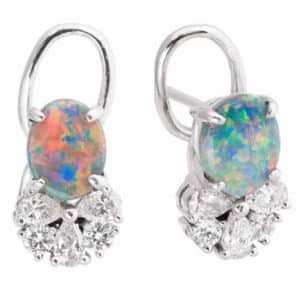
Opal: The Iridescent Beauty of October
Let’s start with opal, the original October birthstone.
Opal has been cherished and revered for millennia, believed to bring luck to those who wear it. While traditionally recognized as the birthstone of October, opal’s iridescence paints a vivid spectrum of colors from the gentle milky whites to deep blacks, all interspersed with flashes of yellow, orange, green, red, and blue.
The word “opal” traces its roots to the Greek word “Opallos,” symbolizing a shift in color. It’s kaleidoscope of hues provides a visual symphony that changes with the light and angle, offering a unique experience each time.
History & Origins of Opal
Long before its listing as birthstone by the American National Retail Jeweler’s Association in 1912, opal was mined in diverse locations like Ethiopia and Australia. Each geographical location contributes to its distinctive character and hues.
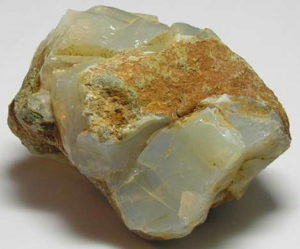
Opal’s Formation & Composition
Opal’s beauty lies in its amorphous nature, making it a mineraloid rather than a conventional mineral. Comprised of silicon dioxide and water, the internal structure, laden with minuscule silica spheres, gives opal its iconic shimmer. This unique play of light ensures that each opal is as unique as a fingerprint.
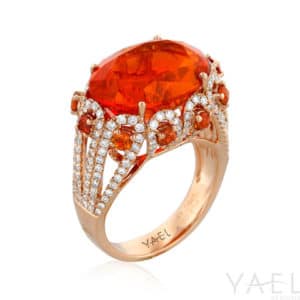
Diverse Types of Opal
Australia stands as the titan in opal production, contributing to almost 90% of the world’s supply. Yet, several other countries, including Brazil, the United States, and Ethiopia, have also produced unique opal varieties.
Here are a few types of opal:
- Boulder Opal: This carries fragments of its host rock, lending it a raw, earthy appearance.
- Harlequin Opal: Known for its square blocks of color.
- Fire Opal: A passionate display of warm, fiery colors ranging from reds and oranges to yellows.
- Black Opal: Features a dark, mysterious body color.
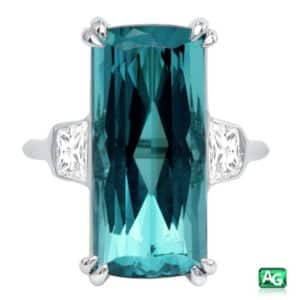
Tourmaline: The Multicolored Gemstone of Modernity
Though tourmaline doesn’t share the same age-old history as opal, it’s no less fascinating. Often referred to as the “Rainbow Gemstone,” it has captivated both jewel aficionados and designers alike. Its availability in many shades makes it an unmatched favorite in the jewelry world.
History & Origins of Tourmaline
Spanning over 500 years, tourmaline has at times been mistaken for emeralds and rubies, a testament to its bewitching beauty.
Tourmaline was officially added to the October birthstone list in 1952 by American National Retail Jeweler’s Association, which had by that time changed its name to Jewelers of America.
The quest for the perfect tourmaline might take you around the globe, from the mines of Brazil and Afghanistan to the terrains of East Africa and the United States. However, its hues and quality might vary, and hence gemstones from certain regions are particularly sought after by collectors.
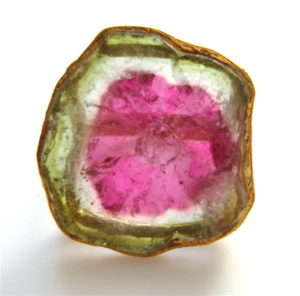
Tourmaline’s Formation & Attributes
Tourmaline is formed by a crystalline boron silicate mineral amalgamated with various elements like iron, magnesium, and potassium. What’s captivating is that certain tourmaline gems are magnetic. When warmed, they can attract lightweight particles.
Due to their resilience (7-7.5 on the Mohs Hardness Scale), tourmalines are adept for diverse jewelry types, from rings to necklaces and earrings.
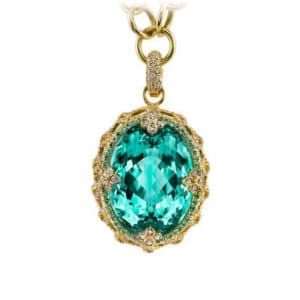
Diverse Types of Tourmaline
A standout characteristic of tourmaline is its ability to flaunt multiple colors within a single stone. These bi-color or tri-color marvels can showcase a stunning array of combinations.
- Schorl: Dark or black in color and the most common.
- Dravite: Ranging from yellow to black.
- Elbaite: Displaying colors from red and blue to green or even colorless.
- Watermelon: Mimics the shades of its namesake fruit with green, pink, and white bands when fashioned into thin slices.
- Paraíba: From the Paraíba region in Brazil.
- Indicolite: Features a deep blue hue.
- Rubellite: Features a deep red hue.
Get the October Birthstone Palette
Whether you’re commemorating an October birthday, anniversary or other significant event during this fall month, your choice between opal and tourmaline—and the diverse types of both gemstones—offers jewelry tailored to every style.
Commemorate October celebrations with these gemstones. Find an American Gem Society jeweler near you today to get started.